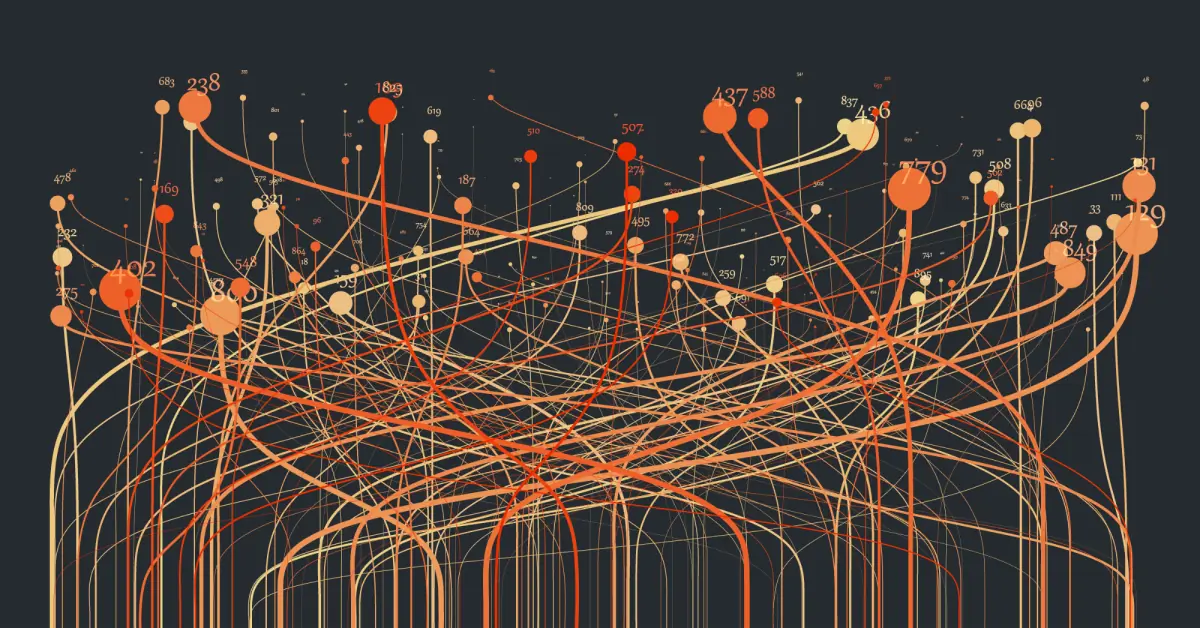Observability for digital transformation
Digital transformation requires organizational evolution. Constant demand for rapid delivery of upgrades and new products forces change. Surely, the old days of managing monolithic applications housed in private servers are over. Applications consist of virtualized, containerized, and serverless code that’s networked via APIs across a hybrid infrastructure of public and private clouds.
The evolved IT ecosystem is complex and difficult to manage without proper tools. Information must be communicated clearly, concisely, and consistently. Furthermore, information silos make effective communication extremely difficult. DevOps and FinOps create processes for effective collaboration. These processes require an infrastructure that supports a holistic view of the IT infrastructure. Without observability, digital transformation drowns in a sea of siloed IT complexity.

Digital complexity
The demand for new apps, services, and upgrades to existing apps is grinding and constant. To be sure, end users have little patience for poor service and delayed gratification. This need created modular microservices that could be networked across multiple infrastructures. The rapid adoption of cloud computing enabled this architectural change. However, this architecture rapidly becomes so complex that it risks devolving into chaos.
Causes of complexity
Applications are no longer monolithic. They’re broken into modular workloads that are networked via APIs. Developers network the workloads to create the application or service. Many services, such as credit card processing, are modularized and can be used in multiple applications. This speeds up development but creates a growing network of dependencies that are difficult to document.
Workloads now have the following characteristics: variable persistence, variable codebases, and various deployment models. To enumerate, the deployment models include legacy monolithic applications, virtualized, microservices, containers, serverless, Docker, and Kubernetes.
Workloads are deployed on the following types of infrastructure:
Storage and compute infrastructure, including multicloud, private, hybrid, and legacy
Network infrastructure, including legacy hardware, SD-WAN , MPLS , cloud, carriers, SDN , and virtual hardware
This distributed architecture is necessary. However, it’s difficult to manage and maintain without proper tools. The massive number of changing variables can create chaos. And without a doubt, chaos eliminates the advantages of the new architectures and will degrade digital transformation progress.
The massive number of changing variables can create chaos.
Causes of complexity chaos
Digital chaos has several causes. Complexity challenges include multiple management consoles, cross-stack application dependencies, constant configuration changes and updates, alert flooding, evolving topology, multiple telemetry databases, and data silos. Complexity issues include alert fatigue; difficulty finding root causes, which increases downtime and slows problem resolution; human error; employee burnout due to stress; finger-pointing; inefficient vendor management; inability to effectively model infrastructure impacts and capacity planning; and reduced confidence in IT.
These causes can overwhelm staff. For example, say the help desk is dealing with a major problem at 4 a.m. A cascade of alerts comes pouring in from multiple monitoring tools. Clients are calling demanding answers. However, the application dependencies are obscured by constant configuration changes that are difficult to document. In many cases, changes are recorded in siloed databases. Vendor TAC centers are demanding log files and traces, while looking for every opportunity to finger-point the problem away. The problem could be anything from a bad port on a switch to a misconfigured API that connects serverless code to application business logic.
The new architecture is impossible to manage with old-school monitoring tools. Monitoring basically tells you that something is working or it isn’t , with no insights into the deeper layers of your IT environment to understand what is really going on. It requires massive amounts of management overhead to enforce change management and other policies and procedures. The stress of rapid deployment creates an error-prone environment. It’s difficult for business units to understand and model the impacts of new initiatives.
The new architecture is impossible to manage with old-school monitoring tools.
Finally, it can be time-consuming and tedious to determine the root cause when multiple, siloed domains are involved throughout your IT stack (here comes the finger-pointing again). The solution for all of this chaos is to evolve from a monitoring platform to an observability platform. Observability provides deeper insights into the health of your environment , dependencies between components and cause and effect actions. (“We updated our online banking solution and conflicts from that caused a ripple effect across the interdependencies with our back office systems.”)
Observability
Monitoring sees the trees, whereas observability sees the forest. Not only does observability see the forest, it enables an understanding of how the trees and every other forest element work together over time. Observability uses external outputs to determine the internal states of a system. It intelligently analyzes the output from monitoring and telemetry as well as other sources of data. Observability integrates outputs from the full stack to create a holistic view of IT infrastructure over time. Monitoring provides details about components and is an observability subset. Observability places monitoring outputs in context while creating a realistic understanding of infrastructure behavior.
Observability challenges
Observability requires understanding over time ephemeral workloads with potentially different codebases that are networked via APIs across multiple clouds (or on-premise, too) with proprietary management interfaces. In addition, workloads traverse hybrid infrastructures of hardware- and software-based switches, routers, and security appliances. The underlying network comprises multiple carriers. These carriers provide everything from SD-WAN to open internet connections.
The who, what and why of observability
Digital transformation changes the entire organization. The IT ecosystem becomes ever more critical. Every business unit depends on its health, from the C-suite to the help desk. In other words, observability gives each business unit a view into how the IT ecosystem affects their operations and its current health. This section deals with who needs observability, what they are observing, and why they are observing it.
Observability gives each business unit a view into how the IT ecosystem affects their operations.
Observability gives each stakeholder a view into the IT infrastructure. For example, the CEO needs to know if the current infrastructure can support current and future business plans, whereas an analyst may be ranking vendors to determine their cost and performance impact on SLA adherence. DevOps may wish to model the impact of a new deployment on capacity, whereas network engineers need to predict future outages. Observability explains infrastructure behavior to stakeholders by making sense of the ever-changing IT environment.
Vendor TAC engineers and system architects also benefit from observability. Other factors stakeholders can observe include mean time to repair; mean time to respond; availability; application and network performance; application, network, and web services usage; configuration changes; and end-user statistics.
In addition to the reasons already given, stakeholders monitor observability to establish baseline infrastructure behavior, predict future issues, inform their capacity planning and budgeting, measure SLA performance, reduce human error, analyze trends and root causes, and perform predictive analytics.
How to meet the observability challenge
It’s difficult to impossible to meet the challenge in a siloed environment that relies on human intellect to sift through terabytes of metrics to figure out what is going on within the IT stack. Change is too fast , and infrastructure architecture is too complicated for the human mind. Therefore, an observability platform powered by AI is required to meet the challenge.
AI is required to create order out of digital chaos. The rapid output of messages from multiple sources is too much for the human mind. AI sorts through the alert noise to create a unified observability console. In addition, modules such as StackState’s Autonomous Anomaly Detector dig deep into the data to provide root cause analysis. It provides insights into data behavior and patterns, as well as aiding in root cause analysis.
4T data fabric
StackState is an example of a proactive observability platform, powered by topology. The StackState platform uses AIOps along with its 4TⓇ Data Model to create order out of complexity chaos. To enumerate, the four Ts are:
Topology
Telemetry
Traces
Time
The StackState engine integrates and correlates data from existing tools, applications and databases into a unified data fabric. It uses the telemetry and metrics information to create a full stack infrastructure topology. Dependencies and code-level insights are traced through the topology. The engine enables time travel to determine how changes affected the topology. Also, the platform captures and accounts for every event, at every moment in time.
The 4T Data Model consolidates the output from data silos to create a unified data fabric. This includes the ability to integrate the 4T data fabric into an organization's data lake . Every change that breathes data is captured and accounted for. Accordingly, AI and ML create actionable insights from the data.
4T is an open model that can work with various telemetry and other output sources, including OpenTelemetry .
AIOps
The rate of change and logarithmic increase in complexity in today's infrastructure is overwhelming. Obviously, the unaided human mind can’t efficiently deal with the reams of data coming out of today’s dynamic IT environments. Fortunately, AI and ML provide tools to extend observability and create order out of IT chaos. StackState provides an out-of-the-box AI algorithm that starts ordering chaos within two hours .
The StackState engine has various capabilities, including modeling, topology map, alert filtering and correlation, predictive analytics, time travel to analyze state changes, and automation. In addition, you can also use it to detect anomalies and undocumented configuration changes and establish baseline behavior.

Observability benefits
The unrelenting demands to meet end-user needs create organizational stress. Stress causes mistakes, organizational tension, and a difficult work environment. Confusion and a lack of clarity compound stress. Human resources must relentlessly document needs, perform difficult troubleshooting, correct mistakes, and deal with other incident and performance management issues. As a result, valuable resources are diverted from their main tasks to deal with time-consuming, tedious problems. Quality IT professionals are in high demand. Thus, providing them with proper tools will reduce stress and create a more positive work environment. This improves retention and lessens the need for ongoing recruitment.
The StackState approach to topology-powered observability reduces stress and accelerates digital transformation by providing many benefits. It reduces staff frustration and stress that cause errors—and there’s a lot of potential for stress here. For example, there’s nothing more stressful than having to resolve incidents due to undocumented configurations. Stress also arises from staff trying to correlate information from multiple vendor consoles by creating a Single Plane of Glass for observability. But thanks to StackState, staff spend less time documenting and solving problems and more time improving business outcomes.
The StackState approach to topology-powered observability reduces stress and accelerates digital transformation by providing many benefits.
Other benefits include reduced MTTR, automated alert correlation, automated traces of data packet flow, intelligent alert filtering, elimination of data silos, end-to-end full stack intelligence, and improved compliance.
In addition, there are benefits for automated root cause analysis , incident prediction (including improved DevOps performance), capacity planning, consistent view of infrastructure , increased customer satisfaction , and business planning .
Summary
The ultimate observer of your digital transformation initiative is the end user. Their experience will determine your initiative’s success. Therefore, it’s critical to have the tools in place to provide the most positive digital experience. An observability tool is vital to providing the best end-user experience.
Digital transformation requires a very complex and rapidly changing IT ecosystem. Thus, the pace of change can overwhelm staff and compromise the end-user digital experience. Organizations need to understand how this infrastructure operates and the impact of change on existing services. Unfortunately, demand-created change creates incomprehensible complexity.
Fortunately, AI-powered observability platforms can aid human staff in dealing with complexity. Another key point: StackState’s platform uses easy-to-implement ML algorithms to create a unified data fabric that can trace code and other dependencies through time across infrastructure topology.
Observability tools are a requirement for effective digital transformation. StackState’s observability platform relieves staff of the burden of constantly trying to document and comprehend the ever-changing IT infrastructure. Gone are the days of spending hours trying to resolve an issue only to find out an undocumented change caused the problem or trying to deploy a new initiative and find out too late that there’s not enough bandwidth.
Observability empowers digital transformation. An efficient and well-designed observability tool makes an efficient digital transformation process. StackState has developed a tool that eliminates complications caused by change and complexity. All things considered, the elegance of their interface and design will improve staff and end-user satisfaction.



